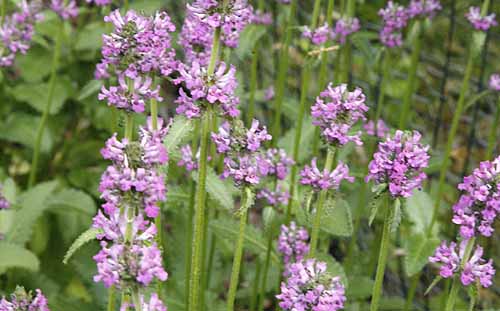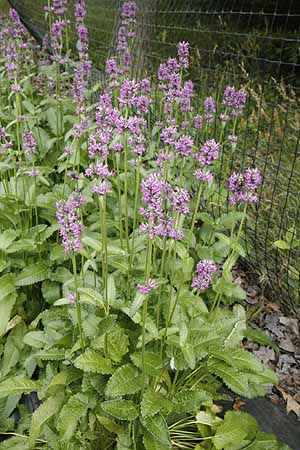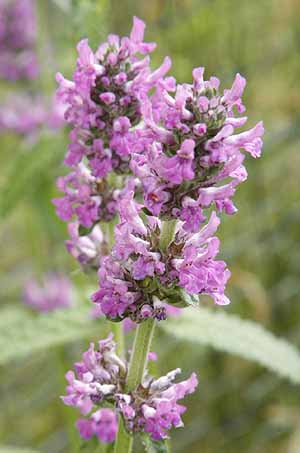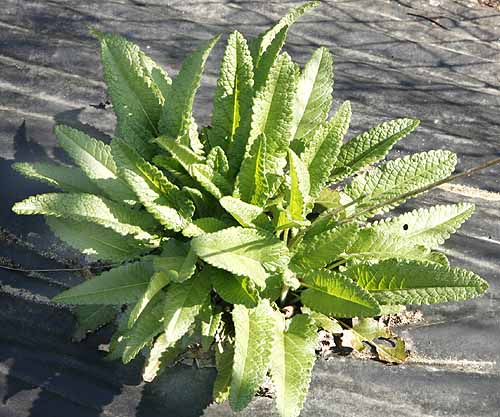Wood betony is a wonderful perennial plant for shady areas. It will happily grow under deciduous trees, around tree lines and north sides of buildings. Anywhere there is shade. It does need some light so avoid extremely dense shade, it will also not grow under coniferous trees. Prefers cooler areas and is very tough. Hardy to zone 4 but not recommended below zone 8 due to the heat. Not fussy about soil type as long as not waterlogged. Easy to grow with attractive mid green leaves in rosettes and showy spikes of purple flowers in summertime when little else will flower under trees. Will make a great summer ground cover in shady areas with little maintenance. Leaf litter can be left around plants as mulch which reduces raking. Needs some water in dryer areas as little will reach under leaf canopy even if there is some rain. Wildlife may eat it but butterflies and beneficial insects love the flowers.
Description of Wood Betony (Stachys officinalis).
Wood Betony is a hardy perennial herb hardy to zone 4. In early spring it produces
a rosette of mid green leaves which are shaped like long drawn-out hearts up
to seven inches long with long thin stiff stalks. Leaves are deeply veined making
them strongly textured with strongly scalloped edges and covered with fine hairs.
In mid to late spring strong stiff square stems arise from the center of the
leaf cluster to the height of about 24 - 20 inches. They bear at wide intervals
a pair of leaves identical to those in the basal cluster expect being much smaller.
The top of the stem bears a spike of purple flowers arranged in dense rings
or whorls that bloom from late spring and early summer and last about two months.
Each flower is a tube ending in two lips, the upper is slightly arched and the
lower one flat with three lobes with four stamens close to the tube opening
and arching up to the upper lip. Flowers are followed by small brown seeds that
fall easily from the spike.
HOW TO GROW Wood Betony (Stachys officinalis).
Location and Care
Wood betony is a wonderful shade plant. It will grow in fully shaded positions
under deciduous trees, NOT conifers. Does not like high heat so ensure is well
shaded in zones 7-8. Not recommended below zone 8. Prefers a good soil with
rich loam, and is happy growing in leaf litter. Soil needs to be well drained
cannot tolerate waterlogged soil. Prefers a little light rather than total dense
shade but it great under trees and even in woodlands provided that the canopy
is not fully dense. Some water is best since its usually growing under trees
and will need to compete for water.
Plant at about 12" intervals and it will produce a good total ground cover
in about two years. Weeding will be necessary until plants are established and
any persistent perennials will need to be removed. Some water is recommended
even in areas with high rain since most will not reach the plants under trees.
Can also be grown on woodland edges but does not take full sun well, needs
shade at least half the day and never full noon sunshine. Once established needs
very little care. Leaf litter can be left around plants in winter to help keep
the roots protected if desired. Just ensure leaf litter is not too dense so
plants cant push through in spring. If leaves are removed ensure mulch is added
back in spring when the plants begin to grow to ensure enough food for the growing
plants.
Little maintenance is needed, may want to cut down flower stalks in fall, or
can be left for winter interest.
Growing Wood Betony (Stachys officinalis) from Seed.
Seeds need a period of cold before they will germinate well. All our seeds have
been cold treated before shipping. They also prefer some light to germinate
so sow on the surface of the soil
or at most very lightly cover them. Germination
can be erratic so sow in small pots or individual cell trays for best results.
Sow indoors in mid to later winter and keep seed trays modestly warm but not
hot. Do not use bottom heat, this plant prefers cool temperatures.
Transplant seedlings as they grow large enough to handle. Grow on in small pots
until large enough to harden off outside. Plants grow slowly for the first year
and take some time to establish so it may be late summer or early fall of first
year before they are large enough to set out. Plant out at about 12" intervals
and keep watered while plants establish themselves. Will flower in second year
from seed.
Seed can also be sown directly on the ground in fall or early spring, however since germination is erratic we do not recommend this method.
Harvesting Wood Betony (Stachys officinalis)
Do not harvest plant until well established. Never attempt harvest in the first
year from seed. Leaves can be harvested from early flower bloom until flowers
are almost finished. Flower stalks should be harvested when about half the flowers
are in bloom. Leave at least one third of the leaves and some flowers to ensure
the plant can replenish itself for the next growing season.
Medical uses of Wood Betony (Stachys officinalis).
Wood Betony was once one of the most revered of herbal medicines and was widely
used for a large number of complaints. During the middle ages is was considered
to be the golden gem amongst herbs. Today it is much less used and then usually
in combination with other herbs. The leaves are used as a tincture to treat
migraine headaches, chronic and acute pain mostly in combination with other
nervines. It is also used to stimulate the digestive system and liver and as
an overall tonic for the body. It is also used for 'frayed nerves', pre-menstrual
complaints, poor memory and tension, sore throats caused by allergies or colds,
heartburn, and inflammation due to infections of the urinary tract. Powdered
leaves if inhaled will cause violent sneezing and it has been used as part of
a herbal snuff mixture in the treatment of headaches.
Edible Uses
Can be used as a substitute for black tea, infusion resembles taste and is caffeine
free.
Other uses
A fine yellow dye is obtained from the leaves. Flowers can be dried and used
in displays.
Magical uses Wood Betony (Stachys officinalis).
Apparently Wood betony was once used as a powerful herb against evil. Druids
and other pagan religious use it for purification, protection, and the expulsion
of evil spirits, nightmares, and despair. It can be added to bonfires at midsummer
to help ward off evil spirits.
Name Confusion.
Unfortunately common names are often used for more than one plant and Wood betony
is an excellent example. In most places the name wood betony means Stachys
officinalis which is a native or Europe and has been used for centuries
as a medicinal herb. However there is also a Native American plant Pedicularis
canadensis that in some places is also known by the common name of wood
betony. It bears no little resemblance to true wood betony having yellow flowers
and growing in sunshine with more fern like leaves than true wood betony. This
plants other common name is Lousewort which is a far better description since
there are a fair number of plants in the lousewort family and a couple do look
more like wood betony in that they have purple flowers. This produces more confusion
and the common name of lousewort is sometimes transferred to true betony and
used there also.
It is extremely important to determine which plant you have and which you want to grow. Since one grows in the shade and the other which plant you have and which you want to grow. Since one grows in the shade and the other does not. If growing plants for medicinal purposes it is vitally important that the correct plant be identified. The properties of true wood betony Stachys officinalis are totally different from that of lousewort Pedicularis canadensis. Harmful and detrimental affects could arise if the wrong plant is used.
Other names.
betony, bishopswort, purple betony, Bishopswort, Woundwor, Lousewort.









